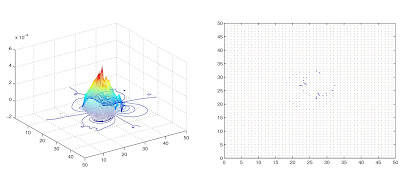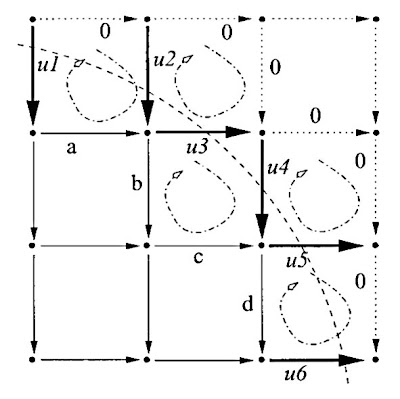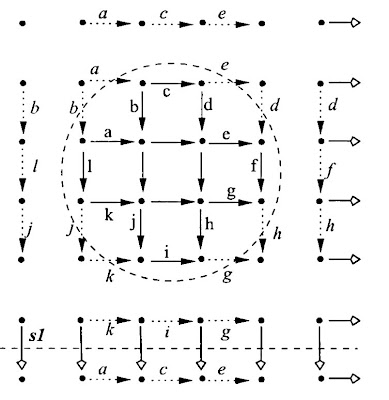 Reconstruction of the wavefront using FFT WFR modified Hudgin method is shown with the circular aperture and central obscuration (outer is 0.9, and inner is 0.1).
Reconstruction of the wavefront using FFT WFR modified Hudgin method is shown with the circular aperture and central obscuration (outer is 0.9, and inner is 0.1). In the case of astronomical telescopes, the gradients are typically available on
a circular aperture. The measurement data cannot be zero padded as it leads to large errors on boundaries. Such errors do not decrease with system size\cite{PoyneerFastFFTreconWFR}.
Because of the spatial periodicity and closed-path-loop conditions (see below), zero-padding the gradient measurements is incorrect. Doing so violates both conditions in general\cite{PoyneerFastFFTreconWFR}. These inconsistencies manifest themselves in errors that span the aperture. The errors do not become less significant as the aperture size increases: unlike the squareaperture case, the amplitude of the error remains large and spans the circular aperture.
Assumptions in the wavefront reconstruction that are not always true
There are two key assumptions in the wavefront reconstruction that must be satisfied for the proper work of the algorithm\cite{PoyneerFastFFTreconWFR}:
- the gradients are spatially periodic (necessary for use of the DFT method, and it must be maintained for a set of gradient measurements). Check if the sum of every row or column in the $N\times N$ gradient signal equals zero.
- any closed path of gradients must sum to zero (based on the modeling of the gradients as first differences).
- all loops (under Hudgin or Fried geometry) must sum to zero;
- both slope signals must be spatially periodic (for DFT)
The boundary problem is solved by using specific methods to make the gradient
sets consistent\cite{poyneer2003advanced}. These methods involve setting the values of specific gradients outside the aperture in a way to guarantee correct reconstruction inside the aperture. By using these methods FT reconstructors accurately reconstruct all sensed modes inside the aperture.
Solutions to the boundary problem: boundary method
The first method is the boundary method: it estimates the gradients that cross the boundary of the aperture\cite{PoyneerFastFFTreconWFR}. It follows directly from the development
above of inside, boundary, and outside gradients. Only the inside gradients are known from the measurement. The outside gradients can all be set to zero leaving the boundary gradients undetermined. A loop continuity equation can be written for each of the two smallest loops that involve a boundary gradient.
 Boundary method. Setting each closed loop across the aperture edge to zero results in an equation relating the unknown boundary gradients to the measured inside gradients and the zeroed outside gradients [picture from the paper \cite{PoyneerFastFFTreconWFR}].
Boundary method. Setting each closed loop across the aperture edge to zero results in an equation relating the unknown boundary gradients to the measured inside gradients and the zeroed outside gradients [picture from the paper \cite{PoyneerFastFFTreconWFR}].$\mathbf{M}u = c$
Here the matrix $M$ is specific for the selected geometry, the $u$ is the vector of all boundary gradients, and the $c$ is a vector containing sums of measured gradients (it has a fixed combination of gradients, but the value of these gradients depends on the actual measurement\cite{PoyneerFastFFTreconWFR}). In the case of noised measurements, the solution can be found using the pseudoinverse of the matrix $M$.
Solutions to the boundary problem: Extention method
The second method is the extension method: it extends out the gradients from inside the aperture. The extension method extends the wavefront shape to
outside the aperture. It does this by a preserving loop continuity\cite{PoyneerFastFFTreconWFR}. The x gradients are extended up and down out of the aperture, while the y gradients are extended to the left and the right.

Extension method, shown for $N=6$. The values of the gradients closest to the aperture edge are repeated outside the aperture [picture from the paper \cite{PoyneerFastFFTreconWFR}].
The extension method produces a completely consistent set of gradients. These provide perfect reconstruction of the phase when there is no noise, except for the piston. If there is noise, the same procedure is done, though loop continuity will not hold on loops involving the seam gradients, just as the boundary gradients in the boundary method were the best, but not an exact, solution when there was noise\cite{PoyneerFastFFTreconWFR}.
References:
\begin{thebibliography}{1}
\bibitem{PoyneerFastFFTreconWFR} Lisa~A. Poyneer, Donald~T. Gavel, and James~M. Brase. \newblock Fast wave-front reconstruction in large adaptive optics systems with use of the fourier transform. \newblock {\em J. Opt. Soc. Am. A}, 19(10):2100--2111, Oct 2002.
\bibitem{poyneer2003advanced} L.A. Poyneer. \newblock {Advanced techniques for Fourier transform wavefront reconstruction}. \newblock In {\em Proceedings of SPIE}, volume 4839, page 1023, 2003.
\end{thebibliography}
No comments:
Post a Comment